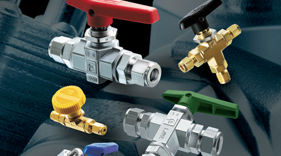

Ball valves are extremely popular in an industrial setting because of their ease of use and simplicity to maintain. They can be manually operated or controlled by pneumatic, hydraulic or electric actuation, and are used to control and manage the fluid flow rate of vapours, liquids and gases. There are various different types of ball valves, so continue reading to discover all of the different ball valve types.
There are five different ball valves types. They are:
They all have different functions, which are explained in detail below.
A full port ball valve (sometimes known as a full bore valve) is generally more expensive than other ball valve types. These valves have an oversized ball so that the hole in the ball is the same size as the pipeline. This results in lower friction loss. With a full port valve, the flow is unrestricted, but the valve is larger.
Full port ball valves are used for throttling applications in various systems with high flow and low pressure drops.
A standard port ball valve is typically less expensive, has a smaller ball and, as a result, a smaller port. Fluid flow through this ball valve type is one pipe size smaller than the valve’s pipe size. This results in a slightly restricted flow.
They have higher pressure drops compared to other ball valve types, and are great for systems with high flow.
The V in the v-port ball valve represents the shape of the seat or the ball, which enables you to control the opening and closing of the valve better. The flow characteristic in this ball valve type is close to linear. Fluids can quickly damage valves, which results in the v-shaped design for a more robust construction.
Multi-port ball valves have multiple ways with a T or L shaped hole in the middle. The L valve can connect the centre port to the side ports, while the T valve is able to connect any pair of ports. Four-way valves have two L-shaped ports in their ball, known as X port.
A reduced port ball valve, also known as an RB or a reduced bore, has a smaller flow area than the pipe, and the flow through the valve is one pipe size smaller than the valve’s pipe size. This type of ball valve creates a pressure drop in the pipeline.
There are two other ball valve types commonly used too. They are:
Fluid Controls supplies quality ball valves from several high profile ball valve manufacturers. Parker Instrumentation design and manufacture a range of high integrity instrumentation valves for worldwide applications. Widely used in industries from analytical through to offshore, the ball valves range includes miniature ball valves, high-pressure ball valves, rotary plug valves and swing out ball valves.
At Fluid Controls, we stock a wide variety of different types of valves, including, check valves, metering valves, high purity valves, ball valves, needle valves, sanitary valves, relief valves and solenoid valves. As valve distributors, our wide array of products means we can cater to whatever valve you are looking for your specific application.
We only work with the finest valve manufacturers, including Parker, Bürkert, Veriflo and Top Line, so we can ensure your product will be of the highest quality. Speak to one of our knowledgeable and experienced advisers today, who will be only too happy to guide you towards selecting the most appropriate valve.
For more information, contact us on +44(0)118 970 2060 or email fluid@fluidcontrols.co.uk.